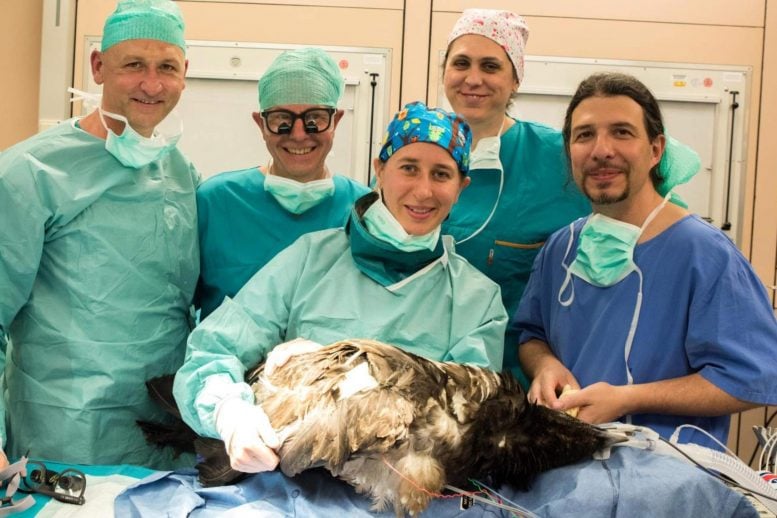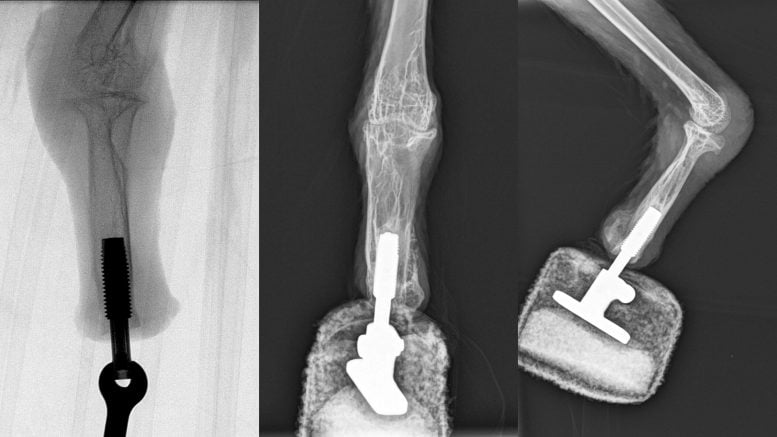
Oskar Aszmann (MedUni Wien), Rickard Branemark (MIT Media Lab USA & Schweden), Sarah Hochgeschurz (VetmedUni Wien), Flavia Restitutti und Attillio Rocchi (beide Dept. Anästhesie der VetmedUni Wien) . Credit: Medical University of Vienna
Bird of prey can land and walk again with two feet and as the first “bionic bird.”
With Oskar Aszmann and his team at the Department of Plastic, Reconstructive and Aesthetic Surgery, MedUni Vienna has long been regarded as a world leader in bionic limb reconstruction. It was only last year that the world’s first fully integrated bionic arm prosthesis was developed at MedUni Vienna. This is ready-to-use and is described as “Plug and Play”. Although all bionic aids have so far been used in humans, the technique known as osseointegration (direct skeletal attachment) has now been used for the very first time in a bearded vulture – the creature was given a new foot. A paper on this ground-breaking procedure has been published in the prestigious journal Scientific Reports.
In large birds such as vultures, the loss of limbs results in the loss of the ability to walk and ultimately to death from malnutrition. The limb can be replaced by a prosthesis but, so far, it has not been possible to use conventional prosthesis shafts in avian limbs, given the extreme loads they have to withstand in daily use.
Life-saving bionic reconstruction
In the case of “Mia” the bearded vulture from the Owl and Bird of Prey Sanctuary in Haringsee (Lower Austria) run by Dr. Hans Frey, Sarah Hochgeschurz from Vienna University of Veterinary Medicine turned to Oskar Aszmann’s team for help. Bearded vultures are the largest flying birds in Europe with a wingspan of up to 2.6 m and this particular bird had injured its foot so badly that it had to be amputated. “However, feet are vital tools for a vulture, not only for landing and walking but also for holding their prey, so that their feet have to withstand various loads,” explains the researcher from Vetmeduni Vienna.
Aszmann adds: “Following a clinical visit to Haringsee, it was clear that the rare bird could not survive long in its current condition. We designed and fabricated a special bone implant that could be surgically attached to the stump.”

“Mia” the bearded vulture can land and walk again with two feet and as the first “bionic bird.” Credit: Medical University of Vienna
This new technique is known as osseointegration and Aszmann’s working group recently used it for the first time in Austria on a patient who had lost an arm – however, it had never previously been attempted on a bird. In osseointegration, external parts of the prosthesis are directly connected to a bone anchor to guarantee a solid skeletal attachment. Aszmann explains: “This concept offers a high degree of embodiment, since osseoperception provides direct intuitive feedback, thereby allowing natural use of the extremity for walking and feeding. For the first time we have now successfully bionically reconstructed the limb of a vulture.”
The operation on the bearded vulture was successfully carried out, together with Rickard Branemark from the Center for Osseointegration Research (San Francisco), at the Center for Biomechanical Research at MedUni Vienna (Director: Bruno Podesser). Rehabilitation and prosthetic treatment took place back in Haringsee. “The bird made the first attempts to walk after just three weeks and the prosthesis was under full load after six weeks. Today the bearded vulture can once again land and walk using both feet, making it the first ‘bionic bird’,” says Aszmann, who is famous throughout the world for his ground-breaking work on bionic hands.
In particular, the case of Patrick Mayrhofer created a sensation in the world media in 2011: the young electrician touched a live circuit at work in 2008 and suffered very severe injuries, losing the use of his left hand. He then decided to have his hand amputated and replaced a few weeks later by a bionic prosthesis at MedUni Vienna – a world first.
Reference: “Avian extremity reconstruction via osseointegrated leg-prosthesis for intuitive embodiment” by Sarah Hochgeschurz, Konstantin D. Bergmeister, Rickard Brånemark, Martin Aman, Attillio Rocchi, Flavia Restitutti, Michaela Gumpenberger, Matthias E. Sporer, Clemens Gstoettner, Anne-Margarete Kramer, Susanna Lang, Bruno K. Podesser and Oskar C. Aszmann, 11 June 2021, Scientific Reports.DOI: 10.1038/s41598-021-90048-2